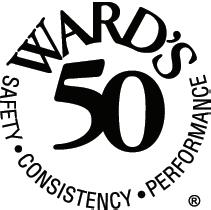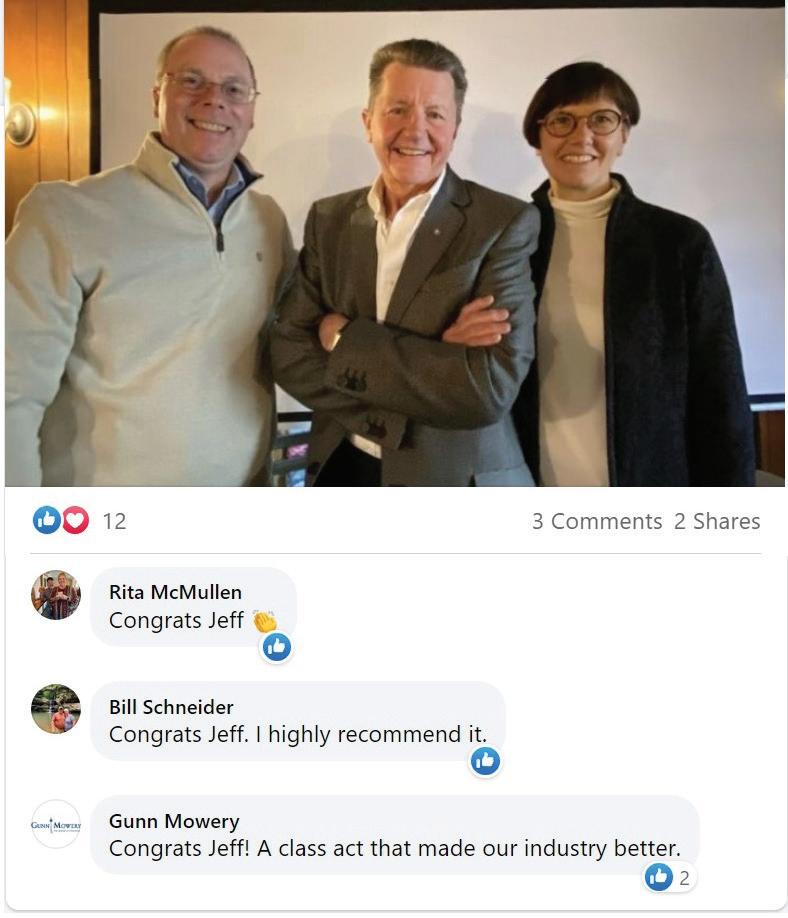






From equipment breakdowns to property damage, our Contractor’s insurance package is an essential tool for those in the business of building. Trust in Tomorrow.® Contact us today.

To find out more about what we can do for you and your customers, contact David Wehr, Sales Manager, at david.wehr@grinnellmutual.com.
“Trust in Tomorrow.” and “Grinnell Mutual” are registered trademarks of Grinnell Mutual Reinsurance Company. © Grinnell Mutual Reinsurance Company, 2023.


IA&B Education Consultant Cathy Trischan discusses how Business Personal Property in a property policy or BOP covers much more than the personal property used in a business.
Gretchen Ruddy, of IA&B Member Agency AMSkier, finds the bright spot: how the pandemic helped her strengthen relationships with her hospitality industry clients. Plus, she shares why she loves her job.


Review the most common reasons that agents experience E&O claims – and tips to avoid them, courtesy of Utica National Insurance Group.
JOIN US ON SOCIAL MEDIA:

Facebook.com/IABforME LinkedIn.com/company/IA and B Twitter.com/IA and B YouTube.com/@IA_and_B
IA&B
Periodical postage paid at Mechanicsburg, PA and at additional mailing offices. Postmaster: Send address changes to Insurance Agents & Brokers, 650 Wilson Lane, Suite 200, Mechanicsburg, PA 17055.
Primary Agent (ISSN 1543-3110), Permit # 638-620, Issue # 2023-01, is published monthly by IA&B Service Group Inc., a subsidiary of IA&B.
Copyright 2023. All rights reserved. No material may be reproduced in whole or in part without wri en consent of the publisher. The information in this publication is general in nature and not intended to serve as legal, accounting, financial, insurance, investment advisory or other professional advice as to any reader’s particular situation. Users are encouraged to consult with competent legal, financial, insurance, investment advisory and/or other professional advisors concerning specific ma ers before making any decisions. We disclaim any responsibility for any decisions or actions by readers. Statements of fact and opinion in Primary Agent are the responsibility of the authors alone and do not imply an opinion on the part of the officers or the members of IA&B. Participation in IA&B events, activities and/or publications is available on a non-discriminatory basis and does not reflect IA&B endorsement of the products and/or services.
While the new year always offers a clean slate, this one feels particularly invigorating for IA&B members. The IA&B Board of Directors and senior staff recently underwent a thorough strategic planning process, and it left us with a refined vision for the future of our agents’ association.
The planning process incorporated feedback from independent agents – those working for small and large, rural and urban member agencies alike. We took into account agents’ current needs, as well as their concerns for the future. The resulting priorities will support independent agents, sustain IA&B, and poise the independent agency system for long-term growth and success.
I encourage you to follow along as IA&B puts this strategic plan into action. Continue to take advantage of your member benefits, and look for refreshed initiatives in the months ahead.
Happy New Year,
Richard M. Rankin Chair of the BoardP.S. The IA&B Board of Directors recognizes that some of our colleagues, particularly in southwest Florida, continue to struggle as they enter the new year due to the devastation caused by Hurricane Ian. In a show of support, our organization made a significant donation to the Trusted Choice® Relief Fund in fall 2022. This fund provides financial assistance to insurance industry personnel impacted by catastrophic occurrences.
Richard M. Rankin, CIC - Chair

Murray Insurance Associates, Inc. | Lancaster, PA

Sarah Brown, CIC, CRM, AFIS - Vice Chair
Keller Brown Insurance Services | Shrewsbury, PA
Greg Benne
Famous & Spang Associates Aberdeen, MD
Kate Dawson, CPIA
Ferri Dawson Insurance Murrysville, PA
Andrew Enders, Esq. Enders Harrisburg, PA
Len Gieseler, LUTCF

Evans Hauseman & Richard, Inc. Po stown, PA
Bruce D. Kra , AAI, CIC
Arbor Insurance Group Allentown, PA
Shayne McIntosh, CIC
JPI Insurance Associates Dillsburg, PA
Chris Miller, CIC
Miller Insurance Protection Team Jonestown, PA
Michael Papa, CIC, MBA
Diversified Insurance Industries, Inc. Hunt Valley, MD
Bill Purdy
Purdy Insurance Agency, Inc. Sunbury, PA
Kent Reynolds, CIC Blue Ridge Risk Partners LLC Hagerstown, MD
Jason Rodriguez
Prominent Insurance Svcs Wilmington, DE
Donna Roper
E K McConkey & Company York, PA
Candace Shoupe, AAI, AIC
CBM Insurance Agency New Castle, DE
Tara Silfies, CPCU Hampson-Mowrer Agency, LLC Bethlehem, PA
Bob Smyrl, CIC
Robert L. Smyrl, Inc. Hatfield, PA
Michael Thomas
Lighthouse Insurance Svcs Gambrills, MD
Mike Ertel (PIA)
The Jacobs Company, Inc. | Columbia, MD
Mark Monroe (IIABA)
Griffith Insurance, LLP | West Chester, PA
Diana Hornung Hanby (IIABA)
IOA National, Inc. | Wilmington, DE
IA&B Legal & Corporate Affairs Director Don Bankus

Contact Don at 717-918-9204 or DonB@IABforME.com.

You’ve all likely been there at one point or another…. You spend the time to get to know and quote a new prospect. The prospect elects to accept coverage from one of your carriers. The two of you complete an ACORD 35 and send it to the prospect’s former agent, who refuses to process the form, arguing the ACORD 35 isn’t valid because no one “witnessed” the insured’s signature.







So, does the ACORD 35 need to be signed by a witness in order to be valid? The short answer is no. Most documents and contracts, including the ACORD 35, don’t require a “witness” signature to be valid and enforceable, even if the document – such as the ACORD 35 – includes a signature line for a “witness.” In addition, the official ACORD 35 instruction form simply states that “… when this document is used as a Policy Release, an insured should have a witness sign and date the form….” The primary function of a having someone “witness” a signature is for evidentiary purposes – meaning, if necessary, the witness can later corroborate they were physically present and actually saw the party sign the document. This is likely why the ACORD 35 instructions suggest the insured “should” have a witness sign and date the form.



















Though not required, if you decide to have the ACORD 35 signed by one or more witnesses, the witness(es) should:

▲ Be at least 18 years of age
▲ Be of sound mind – and not under the influence of drugs or alcohol
▲ Not be a party to the document (e.g. the insureds)






▲ Be physically present when the form is signed by the insured(s)


































While an individual insured cannot “witness” his or her own signature, it is permissible for a producer to sign the cancellation request/policy release form as a “witness.” Just remember the producer would need to actually see the insured sign the form (meaning the producer shouldn’t send the form to the insured for signature via regular mail, email, or fax and then sign as a witness after the insured signs and returns the form to the producer).
This document is not a legal opinion and should not be relied upon as such. The intent of this document is to provide a general background regarding the topic or topics discussed, not to provide legal advice. Producers and agencies should consult an a orney regarding specific situations and specific questions with respect to the topic or topics covered in this document. Neither the Insurance Agents & Brokers nor any of its employees shall be responsible for any errors or omissions regarding any statements made in this document, nor any errors or omissions regarding any statutes, regulations, court rules, and/or any other government documents cited in this document.
When many agents approach a commercial insured who is a tenant, they ask about the value of personal property. To explain what should be included, the agent may ask, “If you turn the building upside down, how much would it cost to replace everything that falls out?”
The answer becomes the limit of insurance, and the conversation ends there. There is so much more, though, to discuss.
Your Business Personal Property in a property policy or Business Personal Property in a businessowners policy (BOP) covers much more than personal property used in the business. Both policies cover the insured’s interest in tenant improvements and betterments (TIB). Many tenants make improvements to their rented space, adding floor and wall coverings, ceiling and wall fixtures, and sometimes even walls themselves.
These improvements must be made or acquired at the tenant’s expense but become part of the building and cannot legally be removed. Failure to ask about and include the value of TIB in the limit of insurance could result in inadequate coverage. Know, too, that if the value of TIB is significant, many insurers will agree to break out the value and apply a lower rate than applies to other types of personal property. On an ISO property policy, Your Business

Personal Property – Separation of Coverage Endorsement CP 19 10 06 95 can be used for this purpose. For insureds with BOPs, insurers may have similar solutions available. Don’t be afraid to ask!




Many insureds are responsible for paying for damage to or even insuring the building. If the tenant is required to insure the entire building, this problem is easily solved. One simply adds building coverage. It is not uncommon, though, for a tenant to be required to insure parts of the building – the building glass or certain equipment such as an HVAC unit. While many BOPs include coverage for exterior building glass for which the tenant is responsible, most property policies do not. And although some insurers have enhancement endorsements that provide some coverage for building components the tenant must insure, most do not.
There is a solution, though, for tenants insured under an ISO property policy. ISO has two endorsements that allow a tenant to insure specific parts of the buildings they rent. The endorsements are Scheduled Building Property Tenant’s Policy (CP 14 01 09 17) and Unscheduled Building Property Tenant’s Policy (CP 14 02 09 17.) As the names suggest, one requires that each item insured be scheduled with a separate limit, while the other does not. With the CP 14 02 09 17, one simply chooses limits for building glass and/or property other than building glass. As long as the tenant is contractually responsible to insure or to pay for loss or damage to the property, coverage applies. For insureds with BOPs, insurers may have similar solutions available.
What about the tenant who is responsible for paying for damage it causes to the rented space? The commercial general liability policy (CGL) includes some coverage for Damage to Premises Rented to You, but this coverage typically applies only if the insured has caused fire damage to the space. In addition, the limit is usually low – $100,000 is common. While some insurers will add additional perils and increase the limit, perhaps even to equal the CGL’s each occurrence limit, one important fact is often overlooked. The Damage to Premises Rented to You coverage is part of the CGL’s each occurrence limit. If the insured causes fire damage to rented space, and the entire $1,000,000 CGL limit is used to pay for fire damage, what will happen when liability claims come in from those injured in the fire? There is no coverage left, and once the limit has been paid, defense coverage ends.
A better solution is the Legal Liability Coverage Form (CP 00 40 10 12), a property form that has features of both property and liability coverage. The tenant insures the building using Basic, Broad or Special Form Causes of Loss. Coverage only applies, though, if the tenant has somehow caused the damage to the building. Simply being contractually liable will not be enough. This useful form is not considered nearly often enough!
Insuring tenant property exposures is not as simple as asking what falls out if one turns the building upside down. Knowing what questions to ask and what solutions to recommend is a win-win for the insured and the agent.
Til next time!
Gretchen Ruddy, CISR is a business insurance agent partner with AMSkier, a full-service independent agency in Hawley, PA. The largest direct insurance provider for children’s camps in the country, AMSkier also offers a full suite of personal and commercial insurance programs.

Q. Why did you enter the insurance industry, and how has your career progressed?
A. In 1998, I graduated with a Bachelor of Arts Degree in Communication Studies from Bloomsburg University and immediately began working for a local, family-owned insurance agency, obtaining my insurance license two months later. I have worked in the industry ever since and joined the AMSkier team in 2014. My entire career has focused on selling and servicing Business Insurance for a variety of different industries.
Q. You now specialize in writing coverage for the hospitality industry. What was that like during the pandemic? And how is that market evolving?
A. Many of the accounts that I work with are in the hospitality industry and suffered tremendously during the pandemic. Our clients really relied on us for guidance and support as they navigated the challenges associated with shutdowns, layoffs, and overall uncertainty. For as difficult as this time was, we were able to strengthen so many of our customer relationships, while being empathetic to each individual situation and circumstance. There were so many things to consider, but in the end, we knew that we were all in it together! Finding creative solutions became our team’s entire focus. It is great to see that so many of our clients and friends are getting back to business as usual.
Q. What’s your favorite part of your job?
A. There are so many things that I love about what I do. I consider myself very lucky to work with the people that I do and to have the opportunity to learn and grow professionally every day. Insurance is just the product that we sell. It is the relationships built along the way that make the lasting impact. Insurance markets and coverages are constantly changing, and staying on top of that keeps things interesting. Every industry is a little different, and learning about what others do and how we can be helpful is very rewarding.
Q. AMSkier is nationally known for its camp program. Tell us about it!
A. For over 90 years, summer camp has been an integral part of the AMSkier world. As a strategic partner for summer camps, we build personal relationships and provide valuable resources and innovative programs that help to improve camps and make them safer. We insure all lines of coverage for this industry as a program administrator.
Q. Thank you for allowing IA&B to place AMSkier’s own E&O insurance. Why do you choose IA&B, and what’s the best part about working with our team?
A. There are so many member resources offered by IA&B. It is comforting to know that their knowledgeable team members are only a phone call away when we are faced with a coverage question or issue where some guidance might be needed. The continuing education courses offered by IA&B also help to keep our entire team up to date on hot topics in the industry. We trust the support offered by IA&B and that they will continue to work hard for us to secure the best E&O protection for our agency.
A. I have lived in Northeastern Pennsylvania my entire life. I love all that our area has to offer. With every changing season, there is something exciting to see or do. There are so many different places to visit, relax, and unwind, which is why so many people visit from bigger cities within driving distance. It is truly a great place to live, work, and raise a family.














A. “The days are long, but the years are short.” The older I get the more this rings true, especially when it comes to my kids and how fast they have grown up. My husband Dennis and I are blessed with three sons – Thomas, Ryan, and Connor. We enjoy attending college football games, lazy Saturdays at the pool, and family/friend get togethers whenever possible. I also enjoy reading and watching movies in my free time.
Q. You live and work in the Poconos region. For those readers who aren’t familiar with Northeastern Pennsylvania, tell us about the area.
Q. What keeps you busy outside of work?
Why do insurance agents receive errors and omissions (E&O) claims? Often it is for failing to execute basic transactions that take place many times each day in your agency. The following are some of the most common reasons that agents experience E&O claims – and tips to avoid them.



For a variety of reasons, an account can “fall through the cracks,” leading to coverage not being bound. Often, this is only discovered once a client submits a claim and realizes there is not coverage in place. Alternatively, coverage may be bound, but not at the terms expected.
■ Do confirm that the carrier received your coverage request. Follow up as needed.






















■ Do review the binder and policy carefully when you receive them to ensure they match the terms quoted.
■ Do have a process to ensure that premiums are quickly provided to the appropriate carrier.









■ Do handle mid-term requests to change coverage quickly, and follow-up frequently until the request is completed.
■ Do be clear to the client that coverage is not in effect until the carrier confirms coverage and, if applicable, do not promise that the coverage will be back-dated.
■ Do treat accounts that are being non-renewed as a priority, keeping a short diary to ensure coverage is replaced prior to the non-renewal date.
■ Do let the insured know as soon as possible if you may not be able to provide an acceptable replacement, allowing them sufficient time to shop the coverage.
Many claims begin with a mistake made on a certificate of








insurance. This can be the result of listing incorrect limits, including additional insureds that are not covered under the policy, or confirming coverage when the policy has been cancelled.
Certificates of Insurance (COIs) are a frequent source of easily preventable E&O claims.
■ Don’t issue a COI until you’ve checked whether the policy has been cancelled or if any endorsements have been added that may modify coverage.



■ Don’t issue a COI listing an additional insured who has not yet been endorsed to the policy.
■ Don’t assume the carrier will approve the additional insured.
■ Do have a second person review the COI for accuracy prior to release.



For P&C agents, this is the most common source of E&O claims. When a client doesn’t receive the coverage they requested or expected, they look to the agent for relief. A lack of a thorough risk analysis is often the root cause of these problems. For renewals, failure to recognize and communicate coverage changes can result in a coverage gap for your client.
It is crucial for agents to perform thorough risk analysis when placing coverage to avoid E&O claims.
■ Use Checklists: Checklists are a great tool to ensure you are not missing vital information on new and renewal business. If possible, have the client review the checklist and acknowledge that all information has been provided.
■ Contact person: Are you speaking to the person who can best supply the information needed to accurately cover the risk?
■ Mirroring coverage: When changing carriers, review the current policy carefully to ensure you are mirroring coverage and point out any coverage differences to the client. Not matching coverage is the most frequent cause of E&O claims on new business.
■ Renewals: Review the policy with the client to determine if any adjustments need to be made due to a change in circumstances. If there are any changes to coverage, this should be pointed out to the client and alternatives offered if necessary. DO NOT depend on your carriers to inform you of changes to the coverage.







Clients often expect their insurance to cover everything. They don’t want to take the time to understand the coverage and will try to put the burden of properly covering their risks on the agent.
■ Point out significant exclusions or restrictions to coverage.
■ Avoid using language such as “apples to apples,” “comprehensive” or “fully covered.” This can give the impression of broader coverage than a policy provides.
■ Use disclaimers on your coverage proposals to put more responsibility on the client.
Thorough documentation of the transaction is critical to defending yourself in the event of an E&O claim. In a “he said, she said” scenario, the agent will lose.
■ Signed, fully completed applications. If possible, have the client initial each page to confirm the information.
■ Coverage refusals. Rejections of optional coverages, refusals of higher limit offers, when a client chooses to self-insure parts of a risk, etc.
■ If you are unable to obtain the coverage the client needs, this needs to be communicated clearly in writing as soon as possible.
■ Back up any verbal communications with an insured in writing. This will help avoid miscommunications and it gives the client an opportunity to respond.
When an agent is not effectively communicating the product they are selling, a client may believe that they were not provided with adequate information to make an informed decision on coverage. This can be of particular concern when an agent works with a wholesaler on a product they lack expertise in. Limit recommendations can be a pitfall for agents when a client finds out they do not have sufficient coverage for a claim.
■ Pass if you don’t fully understand the coverage or risk.
■ Don’t depend on a wholesaler or MGA to supply knowledge you don’t have.
■ Products, such as cyber insurance, evolve quickly, so keep up to date on industry news, take courses and ask questions.


■ Review and update your marketing materials regularly. Inaccurate materials can be used against you if there’s a claim.
■ Avoid using language such as “expert” or “specialist” because you will be held to a higher standard if there’s a claim.
■ Offer multiple limit options and advise clients to review them. You can offer guidance, but clients must assess if the limits are sufficient for their risk.



■ Make sure clients acknowledge that additional limits were offered and they have independently chosen the option they believe best meets their needs.
■ Document discussions about limits in your file and email the client a summary of what was discussed.




































■ Be cautious when using insurance-to-value tools, which may be outdated and not reflect current conditions. Continued on page 11




■ Point out coverage gaps, limitations, and restrictions. Explain coinsurance provisions. Provide clients with the form and endorsements and recommend that they review them thoroughly. Have them confirm they understand the coverage and don’t have any questions.
■ Know if there are specific rating requirements for the coverage your client needs and have the client acknowledge the rating if you’re placing coverage with a carrier not rated by AM Best or Demotech.

When agents set the precedent of notifying clients of pending cancellations, failure to do so can result in a claim when a client has a loss after the cancellation. Failing to offer to assist the client in replacing the cancelled coverage can be another area of exposure.
Some clients are not good at paying their premiums on time. Chasing bad-pay clients creates an exposure for your agency if a client has a claim post-cancellation and you did not provide additional notification.
■ Do not set the precedent of notifying clients of pending cancellations.





■ Do not make payments on behalf of clients to avoid their policy being cancelled.
■ Do offer to obtain replacement coverage as soon as possible once coverage is cancelled – and let the insured know as soon as possible if you may not be able to provide an acceptable replacement.
■ Do not advise that you will be able to cure a gap in coverage due to a cancellation.
Claims that are reported to the agent, but not forwarded to the carrier in a timely manner can result in a denial of coverage. Additionally, an agent may not report the claim under all policies that could respond. This is often an issue when excess or umbrella coverage is in place. An agent may advise a client that “they will be covered” or “there is not coverage” rather than instructing the client to submit the claim to the carrier for coverage determination.
CREATE A CLEAR PROCESS WITH AN EMPHASIS ON DOCUMENTATION TO HELP YOU AVOID E&O CLAIMS.
■ Do have a process to ensure that any claims notice received from an insured is forwarded to the carrier within 24 hours.
■ Do confirm receipt of the claim with the carrier.
■ Do ensure you report the claim to all policies that may have coverage, being particularly aware of excess or umbrella coverage in place as this is often overlooked.
■ Do not advise a client that “you will be covered” or “there is not coverage.” The carrier should determine claims coverage.
■ Do communicate in writing to your client if you do not accept notices of claim, with details on where they should report the claim. If this is discussed verbally, back it up with a written communication.
Important: If you believe there is a potential E&O claim against your agency, report it to the carrier immediately and do not admit liability.
Many claims can be successfully defended with good, uniform procedures and thorough documentation. Instituting appropriate loss control measures can help agents avoid claims while better servicing their clients.
Tabitha L. DeGirolano is E&O Risk Management Specialist and Executive Commercial Lines Underwriter for Utica National Insurance Group.




This information is provided solely as an insurance risk management tool. Utica Mutual Insurance Company and the other member insurance companies of the Utica National Insurance Group (“Utica National”) are not providing legal advice, medical advice or any other professional services. Utica National shall have no liability o any person or entity with respect to any loss or damages alleged to have been caused, directly or indirectly, by the use of the information provided. You are encouraged to consult an a orney or other professional for advice on these issues. © 2021 Utica Mutual Insurance Company
Protect your agency with IA&B’s E&O prevention resources, including sample letters and template disclaimers.
IABforME.com/EO-prevention











































Harford Mutual Insurance Group is a Ward’s 50 ® top-performing property-casualty insurance company for the second consecutive year.

HarfordMutual.com 800.638.3669























There’s no hocus pocus needed to find the right small business coverage.
Think BOP-Pro from UFG Insurance. BOP-Pro helps take the complexity out of small business insurance with more than 35 property and liability coverages. It can even be tailored with coverage boosting endorsements, especially when it comes to the unique needs of restaurants and contractors.
But don’t take our word for it. Check out BOP-Pro products from UFG today. No crystal ball required.

ufginsurance.com/bop-pro






I started working at IA&B in September 2021. I was ready for a change in career and had no insurance knowledge. I was excited to get my feet wet and start learning the basics of insurance.

Prior to working at IA&B, I worked at Sherwin-Williams for five years. I began as a part-time associate and ended my career with them as an Assistant Store Manager. Prior to this, I worked in a couple of other customer service roles. The skills I picked up in these jobs have been vital to my role here at IA&B!













I am the Administrative Assistant at IA&B. Each month, I have a big hand in organizing our mailings and getting them out the door. I am also the first point of contact for our Customer Service team and spend most of my time assisting our members in renewing memberships, registering for courses, and making sure that no question goes unanswered.


















The best part of my job is helping people daily and observing the challenges that they face. Taking those observations and using them to get an overall sense of how to best help our members is something that I take a lot of pride in.
Outside of work, I am a bit of a homebody! I enjoy reading, listening to podcasts, and spending as much time as I can with my fiancé, dog, and cat. Occasionally I will pick up a pencil or a paintbrush and create something, when I have the time.
You can reach Sarah at: 717-918-9219
SarahJ@IABforME.com

















Advance Insurance Group LLC
Reading PA
For information about membership or benefits, contact: Tim Wonder, VP-Membership 717-918-9223
TimW@IABforME.com
DATE TOPIC TIME
Jan 10 Homeowners Deep-Dive: What You Need to Know About the Most Recent Forms 9 AM-12 PM
Jan 10 Chris Amrhein’s “Adventures in Aging”: Medicare & Other Retirement Healthcare Solutions 1-4 PM
Jan 10-11 CIC - Insurance Company Operations 8 AM-5 PM
Jan 11 CISR - Personal Residential 8 AM-3:45 PM
Jan 11 Hour w/ Nicole: Everything You Need to Know About Insuring Work-From-Home Exposures 11 AM-12 PM
Jan 11 Hour w/ Sam: The Policy’s Position on Home-Sharing & How to Handle It 2-3 PM
Jan 12 Inflation & Personal Lines: Helping Insureds Understand Why It Ma ers & What to Do 9 AM-12 PM
Jan 12 Agent’s E&O: Defenses & Preventions for the Insurance Professional 1-4 PM
Jan 17 Marriage, Kids, Money, Assisted Living & Everything Between: Home & Auto Exposures For Life 9 AM-12 PM
Editor: Karen Robison KarenR@IABforME.com 717-918-9209
Contributing editors: Jennifer Ross Megan Fioretta Sarah Jacoby
Sales Account Executive: Laura Gaenzle laura.gaenzle@theygsgroup.com 717-430-2351
Jan 17 Planting the Seed: Agent Strategies to Get & Keep Agribusiness Insureds 1-4 PM
Jan 18 CISR - Agency Operations
Jan 19 Bots, Crypto, Weed & Other Risks You Never Imagined Insuring (But Here We Are)
8 AM-3:45 PM
9 AM-12 PM
Jan 19 Why Good People Do Bad Things: Deep Dive Into Agency Ethics 1-4 PM
Jan 24 Lurking: Surprises In the Contractor’s CGL Policy & Endorsements to Watch Out For 1-4 PM



Jan 25 CISR - Commercial Casualty I
8 AM-3:45 PM
Jan 25 Hour w/ Dave: All-Things Ordinance or Law (Personal & Commercial) 2-3 PM
Jan 26 Covering Online Fraud & Employees Who Turn Out to Be Crooks 1-4 PM

